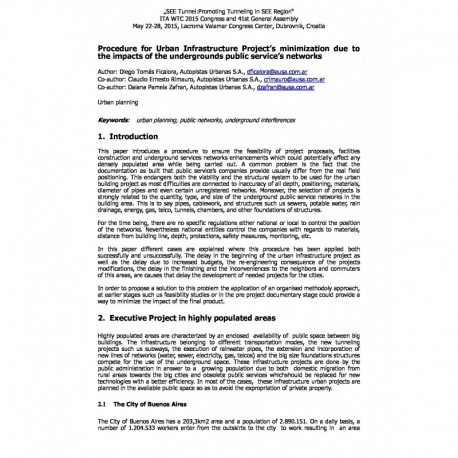Cart
0
0
No document
0,00 €
Total
Document successfully added to your shopping cart
Quantity
Total
There are 0 items in your cart.
There is 1 item in your cart.
Total documents
Total shipping
To be determined
Total
Search & filter
Search for a publication
Search & filter
Procedure for Urban Infrastructure Project’s minimization due to the impacts of the undergrounds public service’s networks
wtc2015_full_ficalora
D. T. Ficalora / C. E. Rimauro / D. P. Zafran
This paper introduces a procedure to ensure the feasibility of project proposals, facilities construction and underground services networks enhancements which could potentially affect any densely populated area while being carried out. A common problem is the fact that the documentation as built that public service’s companies provide usually differ from the real field positioning. This endangers both the viability and the structural system to be used for the urban building project as most difficulties are connected to inaccuracy of all depth, positioning, materials, diameter of pipes and even certain unregistered networks. Moreover, the selection of projects is strongly related to the quantity, type, and size of the underground public service networks in the building area. This is to say pipes, cablework, and structures such us sewers, potable water, rain drainage, energy, gas, telco, tunnels, chambers, and other foundations of structures. For the time being, there are no specific regulations either national or local to control the position of the networks. Nevertheless national entities control the companies with regards to materials, distance from building line, depth, protections, safety measures, monitoring, etc. In this paper different cases are explained where this procedure has been applied both successfully and unsuccessfully. The delay in the beginning of the urban infrastructure project as well as the delay due to increased budgets, the re-engineering consequence of the projects modifications, the delay in the finishing and the inconveniences to the neighbors and commuters of this areas, are causes that delay the development of needed projects for the cities. In order to propose a solution to this problem the application of an organised methodoly approach, at earlier stages such us feasibility studies or in the pre project documentary stage could provide a way to minimize the impact of the final product.




